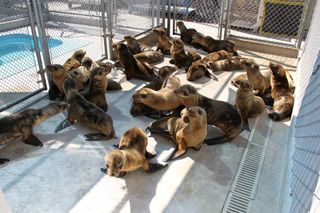Sea Lion Strandings Climb, Scientists Still Stumped

Scientists still don't know why nearly 1,300 sickly sea lions have beached themselves on the shores of southern California since the beginning of the year. However, they think some weird oceanic phenomenon may be blocking off the sea lion pups' source of food, scientists reported today (April 17).
The stranded sea lions — mostly pups born last summer — are typically turning up alive, but severely emaciated, some weighing less than 20 pounds (9 kg) when they should be well over 50 pounds (22 kg), marine officials say.
The National Oceanic and Atmospheric Administration (NOAA) declared an "unusual mortality event" last month in light of the spike in strandings. Since the beginning of the year, 1,293 sea lions have washed ashore from San Diego County to Santa Barbara County. That's more than five times higher than the region's historical average of 236, averaged from the same period of time (January through April) from 2008 to 2012, said Sarah Wilkin, NOAA's marine mammal stranding coordinator for California. [Marine Marvels: Spectacular Photos of Sea Creatures]
The problem is most pronounced in Los Angeles County, where 459 strandings have been reported this year as of April 14. During the same period last year, 60 strandings were reported.
California hasn't seen a spike in starving sea lions on this scale since El Niño warmed up Pacific waters in 1998. El Niño conditions can diminish the upwelling of cold, nutrient-rich water needed to support large populations of fish that are eaten by other animals like sea lions.
"In the words of some of the other biologists, if this was an El Niño year, it would still be overwhelming but it wouldn't be all that surprising," Wilkin said. But this isn't an El Niño year, so the mystery remains.
Wilkin told reporters today (April 17) that biologists think an unseen oceanographic or environmental phenomenon is likely cutting the sea lion pups' supply of food, much like El Niño would. While adult sea lions and other marine mammals may be able to adapt their feeding habits in the face of a shortage, pups are more limited in how far they can travel for food and what they can eat.
Sign up for the Live Science daily newsletter now
Get the world’s most fascinating discoveries delivered straight to your inbox.
A localized anomaly like that happened in 2009, causing an above-average number of strandings.
"The prevailing onshore winds did not blow as strongly as they usually do and it resulted in a lack of upwelling, which created a foraging difficulty for California sea lions," Wilkin explained.
Toxic algae blooms and infectious disease outbreaks also can trigger mass pup strandings. Researchers don't have evidence that either of those factors are contributing to the problem this year, but scientists are still waiting to see if tests on blood and tissue samples turn up bacterial, viral and other infectious agents or radioactive traces.
In a good sign, there has been a slowdown in the number of stranded, starving sea lion pups being admitted to rehab facilities, Wilkin said. At the same time, other animals are washing up. Northern elephant seals have just entered their stranding season and biologists have found a few adult female sea lions suffering from seizures, suggesting they may have been poisoned by the neurotoxin domoic acid, which is produced by multiple species of the genus Pseudo-nitzschia, a type of algae.
Follow Megan Gannon on Twitter and Google+. Follow us @livescience, Facebook & Google+. Original article on LiveScience.com.

Most Popular

